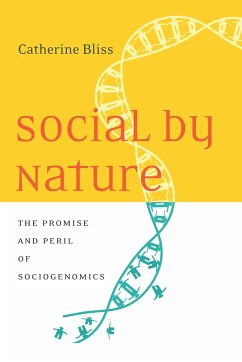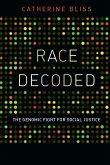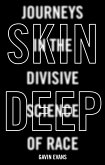- Gebundenes Buch
- Merkliste
- Auf die Merkliste
- Bewerten Bewerten
- Teilen
- Produkt teilen
- Produkterinnerung
- Produkterinnerung
Sociogenomics has rapidly become one of the trendiest sciences of the new millennium. Practitioners view human nature and life outcomes as the result of genetic and social factors. In Social by Nature, Catherine Bliss recognizes the promise of this interdisciplinary young science, but also questions its implications for the future. As she points out, the claim that genetic similarities cause groups of people to behave in similar ways is not new--and a dark history of eugenics warns us of its dangers. Over the last decade, sociogenomics has enjoyed a largely uncritical rise to prominence and…mehr
Andere Kunden interessierten sich auch für
![Race Decoded Race Decoded]() Catherine BlissRace Decoded132,99 €
Catherine BlissRace Decoded132,99 €![Genetic Ancestry Genetic Ancestry]() Jada Benn TorresGenetic Ancestry76,99 €
Jada Benn TorresGenetic Ancestry76,99 €![Socio-economics of Personalized Medicine in Asia Socio-economics of Personalized Medicine in Asia]() Shirley SunSocio-economics of Personalized Medicine in Asia239,99 €
Shirley SunSocio-economics of Personalized Medicine in Asia239,99 €![Kinship and Demographic Behavior in the Past Kinship and Demographic Behavior in the Past]() Tommy Bengtsson / Geraldine P. Mineau (eds.)Kinship and Demographic Behavior in the Past81,99 €
Tommy Bengtsson / Geraldine P. Mineau (eds.)Kinship and Demographic Behavior in the Past81,99 €![Phylogenetic Inference, Selection Theory, and History of Science Phylogenetic Inference, Selection Theory, and History of Science]() Phylogenetic Inference, Selection Theory, and History of Science107,99 €
Phylogenetic Inference, Selection Theory, and History of Science107,99 €![Skin Deep Skin Deep]() Gavin EvansSkin Deep25,99 €
Gavin EvansSkin Deep25,99 €![Fool Proof Fool Proof]() Tess Wilkinson-RyanFool Proof27,99 €
Tess Wilkinson-RyanFool Proof27,99 €-
-
-
Sociogenomics has rapidly become one of the trendiest sciences of the new millennium. Practitioners view human nature and life outcomes as the result of genetic and social factors. In Social by Nature, Catherine Bliss recognizes the promise of this interdisciplinary young science, but also questions its implications for the future. As she points out, the claim that genetic similarities cause groups of people to behave in similar ways is not new--and a dark history of eugenics warns us of its dangers. Over the last decade, sociogenomics has enjoyed a largely uncritical rise to prominence and acceptance in popular culture. Researchers have published studies showing that things like educational attainment, gang membership, and life satisfaction are encoded in our DNA long before we say our first word. Strangely, unlike the racial debates over IQ scores in the '70s and '90s, sociogenomics has not received any major backlash. By exposing the shocking parallels between sociogenomics and older, long-discredited, sciences, Bliss persuasively argues for a more thoughtful public reception of any study that reduces human nature to a mere sequence of genes. This book is a powerful call for researchers to approach their work in more socially responsible ways, and a must-read for anyone who wants to better understand the scholarship that impacts how we see ourselves and our society.
Hinweis: Dieser Artikel kann nur an eine deutsche Lieferadresse ausgeliefert werden.
Hinweis: Dieser Artikel kann nur an eine deutsche Lieferadresse ausgeliefert werden.
Produktdetails
- Produktdetails
- Verlag: Stanford University Press
- Seitenzahl: 304
- Erscheinungstermin: 16. Januar 2018
- Englisch
- Abmessung: 236mm x 156mm x 27mm
- Gewicht: 580g
- ISBN-13: 9780804798341
- ISBN-10: 0804798346
- Artikelnr.: 47778769
- Herstellerkennzeichnung
- Libri GmbH
- Europaallee 1
- 36244 Bad Hersfeld
- gpsr@libri.de
- Verlag: Stanford University Press
- Seitenzahl: 304
- Erscheinungstermin: 16. Januar 2018
- Englisch
- Abmessung: 236mm x 156mm x 27mm
- Gewicht: 580g
- ISBN-13: 9780804798341
- ISBN-10: 0804798346
- Artikelnr.: 47778769
- Herstellerkennzeichnung
- Libri GmbH
- Europaallee 1
- 36244 Bad Hersfeld
- gpsr@libri.de
Catherine Bliss is Associate Professor of Sociology at the University of California, San Francisco. She is the author of Race Decoded: The Genomic Fight for Social Justice (Stanford, 2012), which won the Oliver Cromwell Cox Book Award from the American Sociological Association.
Contents and Abstracts
1Genes and Their Environments
chapter abstract
Chapter 1 provides a social history of the "nature-nurture" divide.
Starting with protobiological notions at work in early modern thought and
moving forward to modern and late modern biology, this chapter reveals the
roots of today's gene-environment emphasis. Situating social genomics amid
long-standing sciences such as sociobiology and behavior genetics, and more
recent fields such as evolutionary psychology and neuropolitics, it
examines the features specific to today's sociogenomic paradigm.
2Science without Borders
chapter abstract
Chapter 2 takes us into the world of social genomics, exposing the who,
what, when, and where of the emerging science. It shows that social
genomics is not a loose network of independent scientists who are working
to benefit the greater good of the sciences more broadly and who have been
stochastically drawn into genetic research as a result of shared concepts,
methods, and expertise. Rather, it is a fast-evolving field with a great
deal of unexamined influence due to its irreverence for discipline.
3Toward the "Deeper Descriptions"
chapter abstract
Chapter 3 shines a light on social genomics' foundational theory and
methodology, including novel approaches like the multicohort GWAS and
multivariate risk analysis, to show the ways the science innovates genetic
explanantia and evolutionary theory. Scientists are currently training
their attention on broader natural science debates, even in their attempts
to usher in their methodology in the social sciences and to interpret the
relevance of their findings for policy. Their focus is less on tackling
deep social science conundrums or participating in policy analysis, and
more on aligning with health and medical science.
4Determining Difference
chapter abstract
Chapter 4 reveals how sociogenomics is remaking societal notions of human
difference in terms of the media as well as basic science characterizations
of race, gender, and sexuality. This chapter builds on prior analyses of
genome science to evince the ways that new avenues in sociogenomics
privilege and perpetuate a genetically deterministic lens for human
difference. It shows that troubling, biologically reductive definitions of
race, gender, and sexuality thrive in a sociogenomic world.
5The Breakthrough
chapter abstract
Chapter 5 uncovers the central "positions and dispositions" of social
genomics, including how participating scientists see their mandate
vis-à-vis science writ large. It shows the ways researchers have formed a
flexible matrix of specialized knowledge in an attempt to produce credible
research innovations and conclusions about the genomics of behavior that
can have an impact on bioscience and the wider public. As scientists have
invested in the notion of moving theory and methods forward for all
sciences, they have formed a confrontational style of practice that is
characterized by a unique brand of pioneerism and optimism.
6A Bigger, Better Science
chapter abstract
Chapter 6 examines the impact social genomics is having on the wider world
of science. It shows how the field is being received and interpreted by its
vast array of collaborator fields, and prioritized by the major funding
agencies of our time. This chapter similarly discusses key successes and
challenges the field faces going forward, pertaining to funding,
governmental support, and scientific publication.
7Applied Science
chapter abstract
Chapter 7 explores the uptake of sociogenomic applications by experts
working in the public domain. Whereas use of genomic applications has
largely been reserved for biomedical settings, sociogenomic applications
have enjoyed adoption in criminal justice, education, and other legal
arenas. This chapter presents the salience of sociogenomics for these
domains, including how experts in the wider public understand and utilize
it, and how the organizations, institutions, and fields they work in
perceive its value. The chapter further uncovers key policy issues that
scientists see as relevant in sociogenomics' expansion to new public
arenas.
8The Business of Sociogenomics
chapter abstract
Chapter 8 presents the array of technologies and therapeutics that have
arisen in the commercial domain of genes and behavior. From inborn talent
tests to genomic matchmaking, a cottage industry in sociogenomic science
has arisen to serve the rising Genome Generation. While only some of these
tests have been a direct result of sociogenomic efforts, their usage
contributes to the popularization of the sociogenomic paradigm in the mass
public. This chapter details the ways the bullish strength of broader
markets in personal genomic technology is spurring on sociogenomics as a
valuable set of personal predictive indicators.
Conclusion
chapter abstract
The Conclusion draws together analyses from the preceding chapters to
consider the meaning of the sociogenomic paradigm in society. Not only is
sociogenomics a scientific orientation, a governmental framework, and a
tool in the expert's toolkit; it is a popular lens for deciphering the
individual, and a game-changer in public notions of human difference. The
analysis ends by signaling meaningful ways that we can critically engage
with sociogenomics so that socially responsible frameworks may take hold.
1Genes and Their Environments
chapter abstract
Chapter 1 provides a social history of the "nature-nurture" divide.
Starting with protobiological notions at work in early modern thought and
moving forward to modern and late modern biology, this chapter reveals the
roots of today's gene-environment emphasis. Situating social genomics amid
long-standing sciences such as sociobiology and behavior genetics, and more
recent fields such as evolutionary psychology and neuropolitics, it
examines the features specific to today's sociogenomic paradigm.
2Science without Borders
chapter abstract
Chapter 2 takes us into the world of social genomics, exposing the who,
what, when, and where of the emerging science. It shows that social
genomics is not a loose network of independent scientists who are working
to benefit the greater good of the sciences more broadly and who have been
stochastically drawn into genetic research as a result of shared concepts,
methods, and expertise. Rather, it is a fast-evolving field with a great
deal of unexamined influence due to its irreverence for discipline.
3Toward the "Deeper Descriptions"
chapter abstract
Chapter 3 shines a light on social genomics' foundational theory and
methodology, including novel approaches like the multicohort GWAS and
multivariate risk analysis, to show the ways the science innovates genetic
explanantia and evolutionary theory. Scientists are currently training
their attention on broader natural science debates, even in their attempts
to usher in their methodology in the social sciences and to interpret the
relevance of their findings for policy. Their focus is less on tackling
deep social science conundrums or participating in policy analysis, and
more on aligning with health and medical science.
4Determining Difference
chapter abstract
Chapter 4 reveals how sociogenomics is remaking societal notions of human
difference in terms of the media as well as basic science characterizations
of race, gender, and sexuality. This chapter builds on prior analyses of
genome science to evince the ways that new avenues in sociogenomics
privilege and perpetuate a genetically deterministic lens for human
difference. It shows that troubling, biologically reductive definitions of
race, gender, and sexuality thrive in a sociogenomic world.
5The Breakthrough
chapter abstract
Chapter 5 uncovers the central "positions and dispositions" of social
genomics, including how participating scientists see their mandate
vis-à-vis science writ large. It shows the ways researchers have formed a
flexible matrix of specialized knowledge in an attempt to produce credible
research innovations and conclusions about the genomics of behavior that
can have an impact on bioscience and the wider public. As scientists have
invested in the notion of moving theory and methods forward for all
sciences, they have formed a confrontational style of practice that is
characterized by a unique brand of pioneerism and optimism.
6A Bigger, Better Science
chapter abstract
Chapter 6 examines the impact social genomics is having on the wider world
of science. It shows how the field is being received and interpreted by its
vast array of collaborator fields, and prioritized by the major funding
agencies of our time. This chapter similarly discusses key successes and
challenges the field faces going forward, pertaining to funding,
governmental support, and scientific publication.
7Applied Science
chapter abstract
Chapter 7 explores the uptake of sociogenomic applications by experts
working in the public domain. Whereas use of genomic applications has
largely been reserved for biomedical settings, sociogenomic applications
have enjoyed adoption in criminal justice, education, and other legal
arenas. This chapter presents the salience of sociogenomics for these
domains, including how experts in the wider public understand and utilize
it, and how the organizations, institutions, and fields they work in
perceive its value. The chapter further uncovers key policy issues that
scientists see as relevant in sociogenomics' expansion to new public
arenas.
8The Business of Sociogenomics
chapter abstract
Chapter 8 presents the array of technologies and therapeutics that have
arisen in the commercial domain of genes and behavior. From inborn talent
tests to genomic matchmaking, a cottage industry in sociogenomic science
has arisen to serve the rising Genome Generation. While only some of these
tests have been a direct result of sociogenomic efforts, their usage
contributes to the popularization of the sociogenomic paradigm in the mass
public. This chapter details the ways the bullish strength of broader
markets in personal genomic technology is spurring on sociogenomics as a
valuable set of personal predictive indicators.
Conclusion
chapter abstract
The Conclusion draws together analyses from the preceding chapters to
consider the meaning of the sociogenomic paradigm in society. Not only is
sociogenomics a scientific orientation, a governmental framework, and a
tool in the expert's toolkit; it is a popular lens for deciphering the
individual, and a game-changer in public notions of human difference. The
analysis ends by signaling meaningful ways that we can critically engage
with sociogenomics so that socially responsible frameworks may take hold.
Contents and Abstracts
1Genes and Their Environments
chapter abstract
Chapter 1 provides a social history of the "nature-nurture" divide.
Starting with protobiological notions at work in early modern thought and
moving forward to modern and late modern biology, this chapter reveals the
roots of today's gene-environment emphasis. Situating social genomics amid
long-standing sciences such as sociobiology and behavior genetics, and more
recent fields such as evolutionary psychology and neuropolitics, it
examines the features specific to today's sociogenomic paradigm.
2Science without Borders
chapter abstract
Chapter 2 takes us into the world of social genomics, exposing the who,
what, when, and where of the emerging science. It shows that social
genomics is not a loose network of independent scientists who are working
to benefit the greater good of the sciences more broadly and who have been
stochastically drawn into genetic research as a result of shared concepts,
methods, and expertise. Rather, it is a fast-evolving field with a great
deal of unexamined influence due to its irreverence for discipline.
3Toward the "Deeper Descriptions"
chapter abstract
Chapter 3 shines a light on social genomics' foundational theory and
methodology, including novel approaches like the multicohort GWAS and
multivariate risk analysis, to show the ways the science innovates genetic
explanantia and evolutionary theory. Scientists are currently training
their attention on broader natural science debates, even in their attempts
to usher in their methodology in the social sciences and to interpret the
relevance of their findings for policy. Their focus is less on tackling
deep social science conundrums or participating in policy analysis, and
more on aligning with health and medical science.
4Determining Difference
chapter abstract
Chapter 4 reveals how sociogenomics is remaking societal notions of human
difference in terms of the media as well as basic science characterizations
of race, gender, and sexuality. This chapter builds on prior analyses of
genome science to evince the ways that new avenues in sociogenomics
privilege and perpetuate a genetically deterministic lens for human
difference. It shows that troubling, biologically reductive definitions of
race, gender, and sexuality thrive in a sociogenomic world.
5The Breakthrough
chapter abstract
Chapter 5 uncovers the central "positions and dispositions" of social
genomics, including how participating scientists see their mandate
vis-à-vis science writ large. It shows the ways researchers have formed a
flexible matrix of specialized knowledge in an attempt to produce credible
research innovations and conclusions about the genomics of behavior that
can have an impact on bioscience and the wider public. As scientists have
invested in the notion of moving theory and methods forward for all
sciences, they have formed a confrontational style of practice that is
characterized by a unique brand of pioneerism and optimism.
6A Bigger, Better Science
chapter abstract
Chapter 6 examines the impact social genomics is having on the wider world
of science. It shows how the field is being received and interpreted by its
vast array of collaborator fields, and prioritized by the major funding
agencies of our time. This chapter similarly discusses key successes and
challenges the field faces going forward, pertaining to funding,
governmental support, and scientific publication.
7Applied Science
chapter abstract
Chapter 7 explores the uptake of sociogenomic applications by experts
working in the public domain. Whereas use of genomic applications has
largely been reserved for biomedical settings, sociogenomic applications
have enjoyed adoption in criminal justice, education, and other legal
arenas. This chapter presents the salience of sociogenomics for these
domains, including how experts in the wider public understand and utilize
it, and how the organizations, institutions, and fields they work in
perceive its value. The chapter further uncovers key policy issues that
scientists see as relevant in sociogenomics' expansion to new public
arenas.
8The Business of Sociogenomics
chapter abstract
Chapter 8 presents the array of technologies and therapeutics that have
arisen in the commercial domain of genes and behavior. From inborn talent
tests to genomic matchmaking, a cottage industry in sociogenomic science
has arisen to serve the rising Genome Generation. While only some of these
tests have been a direct result of sociogenomic efforts, their usage
contributes to the popularization of the sociogenomic paradigm in the mass
public. This chapter details the ways the bullish strength of broader
markets in personal genomic technology is spurring on sociogenomics as a
valuable set of personal predictive indicators.
Conclusion
chapter abstract
The Conclusion draws together analyses from the preceding chapters to
consider the meaning of the sociogenomic paradigm in society. Not only is
sociogenomics a scientific orientation, a governmental framework, and a
tool in the expert's toolkit; it is a popular lens for deciphering the
individual, and a game-changer in public notions of human difference. The
analysis ends by signaling meaningful ways that we can critically engage
with sociogenomics so that socially responsible frameworks may take hold.
1Genes and Their Environments
chapter abstract
Chapter 1 provides a social history of the "nature-nurture" divide.
Starting with protobiological notions at work in early modern thought and
moving forward to modern and late modern biology, this chapter reveals the
roots of today's gene-environment emphasis. Situating social genomics amid
long-standing sciences such as sociobiology and behavior genetics, and more
recent fields such as evolutionary psychology and neuropolitics, it
examines the features specific to today's sociogenomic paradigm.
2Science without Borders
chapter abstract
Chapter 2 takes us into the world of social genomics, exposing the who,
what, when, and where of the emerging science. It shows that social
genomics is not a loose network of independent scientists who are working
to benefit the greater good of the sciences more broadly and who have been
stochastically drawn into genetic research as a result of shared concepts,
methods, and expertise. Rather, it is a fast-evolving field with a great
deal of unexamined influence due to its irreverence for discipline.
3Toward the "Deeper Descriptions"
chapter abstract
Chapter 3 shines a light on social genomics' foundational theory and
methodology, including novel approaches like the multicohort GWAS and
multivariate risk analysis, to show the ways the science innovates genetic
explanantia and evolutionary theory. Scientists are currently training
their attention on broader natural science debates, even in their attempts
to usher in their methodology in the social sciences and to interpret the
relevance of their findings for policy. Their focus is less on tackling
deep social science conundrums or participating in policy analysis, and
more on aligning with health and medical science.
4Determining Difference
chapter abstract
Chapter 4 reveals how sociogenomics is remaking societal notions of human
difference in terms of the media as well as basic science characterizations
of race, gender, and sexuality. This chapter builds on prior analyses of
genome science to evince the ways that new avenues in sociogenomics
privilege and perpetuate a genetically deterministic lens for human
difference. It shows that troubling, biologically reductive definitions of
race, gender, and sexuality thrive in a sociogenomic world.
5The Breakthrough
chapter abstract
Chapter 5 uncovers the central "positions and dispositions" of social
genomics, including how participating scientists see their mandate
vis-à-vis science writ large. It shows the ways researchers have formed a
flexible matrix of specialized knowledge in an attempt to produce credible
research innovations and conclusions about the genomics of behavior that
can have an impact on bioscience and the wider public. As scientists have
invested in the notion of moving theory and methods forward for all
sciences, they have formed a confrontational style of practice that is
characterized by a unique brand of pioneerism and optimism.
6A Bigger, Better Science
chapter abstract
Chapter 6 examines the impact social genomics is having on the wider world
of science. It shows how the field is being received and interpreted by its
vast array of collaborator fields, and prioritized by the major funding
agencies of our time. This chapter similarly discusses key successes and
challenges the field faces going forward, pertaining to funding,
governmental support, and scientific publication.
7Applied Science
chapter abstract
Chapter 7 explores the uptake of sociogenomic applications by experts
working in the public domain. Whereas use of genomic applications has
largely been reserved for biomedical settings, sociogenomic applications
have enjoyed adoption in criminal justice, education, and other legal
arenas. This chapter presents the salience of sociogenomics for these
domains, including how experts in the wider public understand and utilize
it, and how the organizations, institutions, and fields they work in
perceive its value. The chapter further uncovers key policy issues that
scientists see as relevant in sociogenomics' expansion to new public
arenas.
8The Business of Sociogenomics
chapter abstract
Chapter 8 presents the array of technologies and therapeutics that have
arisen in the commercial domain of genes and behavior. From inborn talent
tests to genomic matchmaking, a cottage industry in sociogenomic science
has arisen to serve the rising Genome Generation. While only some of these
tests have been a direct result of sociogenomic efforts, their usage
contributes to the popularization of the sociogenomic paradigm in the mass
public. This chapter details the ways the bullish strength of broader
markets in personal genomic technology is spurring on sociogenomics as a
valuable set of personal predictive indicators.
Conclusion
chapter abstract
The Conclusion draws together analyses from the preceding chapters to
consider the meaning of the sociogenomic paradigm in society. Not only is
sociogenomics a scientific orientation, a governmental framework, and a
tool in the expert's toolkit; it is a popular lens for deciphering the
individual, and a game-changer in public notions of human difference. The
analysis ends by signaling meaningful ways that we can critically engage
with sociogenomics so that socially responsible frameworks may take hold.








